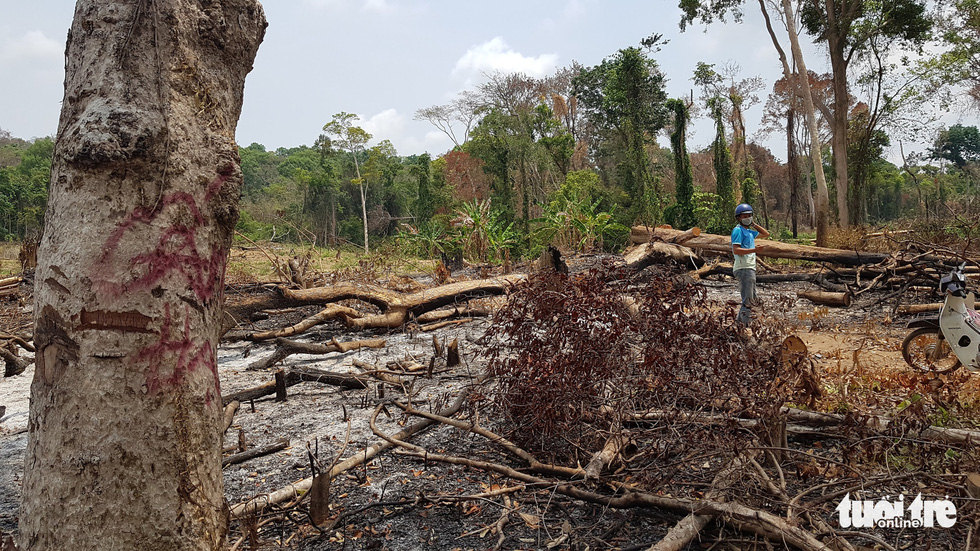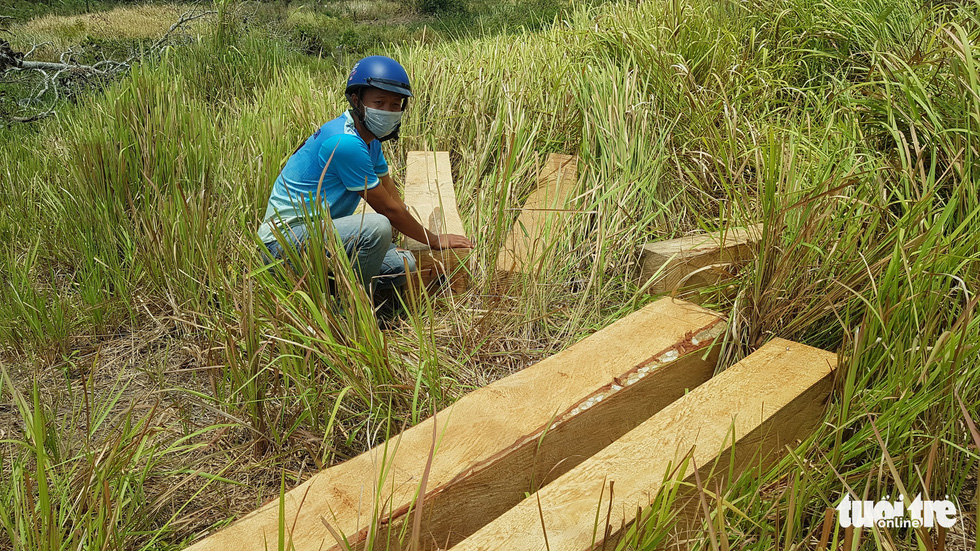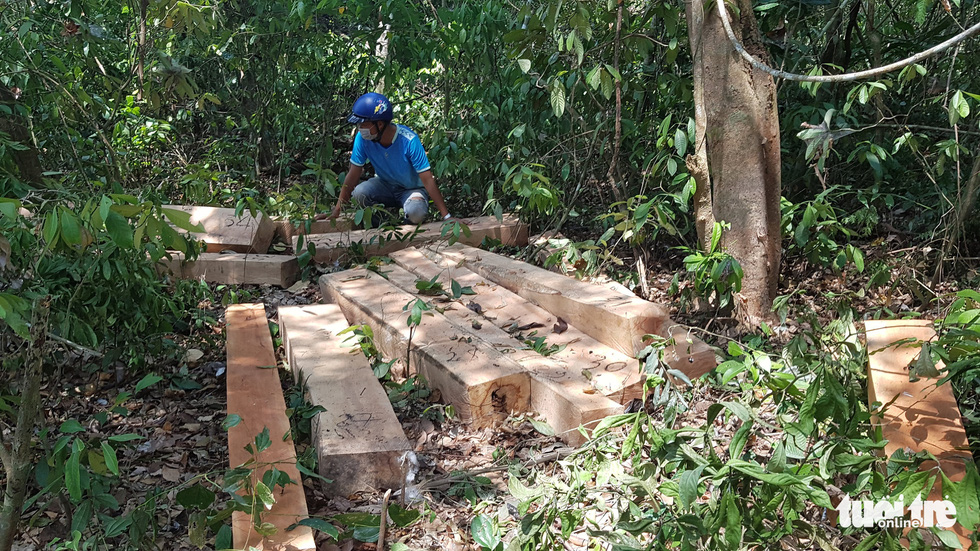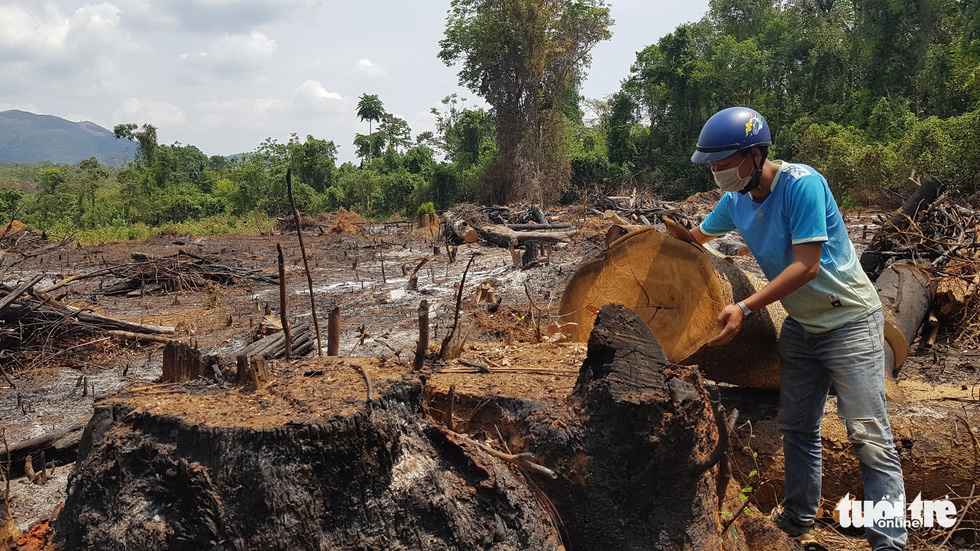A forest located at the border of the Central Highlands provinces of Gia Lai and Dak Lak in Vietnam is being destroyed at an alarming rate by both loggers and local people, a Tuoi Tre (Youth) newspaper’s reporter witnessed during a trip with local rangers.
The wooded area lies at the border between Dak Lak’s Ea Kar District and Gia Lai’s Krong Pa District, encompassing parts of Ea So Nature Reserve, Ia Dreh Commune, and the Nam Song Ba protection forest in the two provinces.
In contrast to the vast swaths of green scenery seen from afar, the core of the forest was almost empty, with tree limbs scattered here and there while their valuable trunks had been smuggled elsewhere by loggers.
The situation has been taking place on a large scale over the past few months.
The branches and leaves left behind have been sun-dried under the sweltering weather, waiting to be ignited into a forest fire that burns the area to ashes, out of which new agricultural land will be made as per farming traditions passed down for generations.
“In the old days, people used to cut down forest trees with axes and machetes, so only a few hectares of forest was being lost in a whole year,” a guide explained to Tuoi Tre.
“But now, with chainsaws, it takes loggers as little as a week to clear several hectares [of forest trees],” he said.
|
|
| Logs lie on the ground in a forest in Ia Dreh Commune, Krong Pa District, Gia Lai Province, Vietnam, April 2020. Photo: Huynh Cong Dong / Tuoi Tre |
Going deeper into the core of the forest, your correspondent spotted huge logs which had been numbered piling up at dozens of collection points, located right on the side of the forest trail with wheel tracks in the size of tractors' still visible on the ground.
“There are two types of loggers in this forest area: one is from other areas who come for the valuable logs which they sell for money, and the other is the local people who need timber to build houses or clear forest land for cultivation,” the guide explained.
According to the guide, loggers from other areas often operate in groups of tens, transport logged trees to collection points on reconfigured motorbikes, and wait for the appropriate time to sneak them out of the forest on bigger tractors.
“The logs are transported to Truong Son Dong Street [which is about 20 kilometers away from the forest’s core], but from there I don’t know where they will end up next,” the guide added.
|
|
| Logs lie on the ground in a forest in Ia Dreh Commune, Krong Pa District, Gia Lai Province, Vietnam, April 2020. Photo: Huynh Cong Dong / Tuoi Tre |
Truong Quoc Dung, head of Krong Pa District’s forest protection unit, told Tuoi Tre that his unit regularly coordinated with the management boards of the Nam Song Ba protection forest and Ea So Nature Reserve to trace loggers in the border area.
The People’s Committee of the district has also set up inter-agency teams to patrol the area, focusing on the forest land in Ia Dreh Commune, Dung said.
According to the ranger, the loggers often take advantage of times when local people carry farm produce and when a local plantation transports legally logged wood out of the forest to smuggle out their illegal timber.
“Noticeably, [logging activities have been more rampant] during the implementation of social distancing,” Dung added, referring to a two-week period between April 1 and 15 during which all people in Vietnam are asked to limit social interaction and refrain from going outdoors as per a prime minister directive to curb the spread of novel coronavirus disease (COVID-19).
|
|
| A large tree is felled and burned in a forest in Ia Dreh Commune, Krong Pa District, Gia Lai Province, Vietnam, April 2020. Photo: Huynh Cong Dong / Tuoi Tre |
Dung said local authorities have discovered four cases of illegally stockpiling forestry products, with more than ten cubic meters of timber being confiscated, since the end of February.
The forest rangers also busted three camps of loggers near Ea So Nature Reserve on March 24.
Most recently, the Krong Pa District forest protection unit discovered over 5.3 cubic meters of logged trees in the forest area on April 11.
In addition, Dung admitted that there have been situations where residents in Gia Lai, Dak Lak and the south-central province of Phu Yen have come to the area and caused deforestation to build temporary houses and cultivate crops.
“There have been 200 such households in the area so far,” said Dung, adding that the local authorities are going all out to thoroughly handle these violations.
Like us on Facebook or follow us on Twitter to get the latest news about Vietnam!


















































